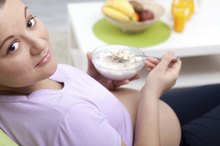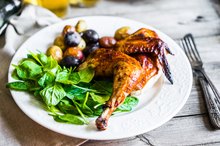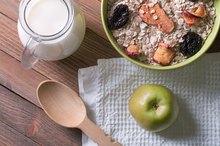30-Day Meal Planner for Diabetics
Managing diabetes well is critical to having a high quality of life while living with the condition. When considering a 30-day meal plan, ensure you can follow the plan long term by taking your lifestyle into consideration. Factors to account for include usual waking time, mealtime, daily schedule, insulin, physical activity and bedtime. Talk to a registered dietitian to make sure your meal plan meets your specific nutrient needs.
Necessary Nutrients
Whether the goal is weight loss or weight maintenance, a 30-day diabetic meal plan should include enough calories, with 50 percent of your total calories from carbohydrates primarily in the form of whole grains, vegetables, beans, fruits and milk. Protein should come from lean protein sources like skinless poultry and fish and make up about 20 percent of total calories, while the remaining 30 percent of calories should come from healthy fats such as nuts, seeds, fish and avocados. As with any healthy meal plan, limit refined and added sugars.
Daily Meal Schedule
The Best Gestational Diabetes Meal Plan
Learn More
Eating carbohydrates consistently throughout the day is key for managing blood sugar. You can accomplish this on a 30-day meal plan by eating three main meals and two or three small snacks. One of the snacks should be shortly before bedtime to help compensate for not eating during the night. Along with carbohydrate foods, include sources of protein and healthy fats in each meal to balance the meal and avoid dramatic spikes in blood sugar.
Carbohydrate Counting
You can use carbohydrate counting on a 30-day diabetic meal plan to allow for a variety of food choices and flexibility. Carbohydrates are the main nutrient in food that affects blood glucose levels. Foods that contain carbohydrates include grains, starchy vegetables, fruit, dairy products and sugary treats. These foods are assigned a specific serving size that equals 15 grams of carbohydrates or one carbohydrate serving. Women generally need three to four carbohydrate servings per meal, or about 45 to 60 grams, while most men need about five to six servings, or 60 to 75 grams of carbohydrates. The Diabetic Exchange List can be used to determine correct portion size for each specific food.
Sample Plans
Diabetic Diet Food List
Learn More
One 28-day eating plan on Eatingwell.com provides three different schedules with caloric levels of 1,200, 1,500 and 1,800. This plan provides a well-balanced diet at each calorie level and even includes links to recipes. However, none of the calorie levels includes more than one snack per day. Multiple snacks spaced evenly throughout the day are preferable to ensure consistent carbohydrate intake throughout the day. The American Diabetes Association "Month of Meals Diabetes Meal Planner" uses carbohydrate counting to plan hundreds of meal combinations. It offers a daily schedule for four different caloric levels, with all schedules calling for three meals and three snacks during the day.
Related Articles
References
- Review of Dietetics; Mary Abbott Hess, LHD, MS, RD, LND, FADA, Editor
- The American Dietetic Association: Ready, Set, Start Counting!
- Eatingwell.com: Diabetic Meal Plans
- The American Diabetes Association Month of Meals Diabetes Meal Planner; The American Diabetes Association
Resources
Writer Bio
Christine Fleming has a master's degree in dietetics. She is passionate about using her degree to help others take care of themselves by eating nutritious foods and leading a healthy lifestyle, enabling people to live the life they were created to live.









